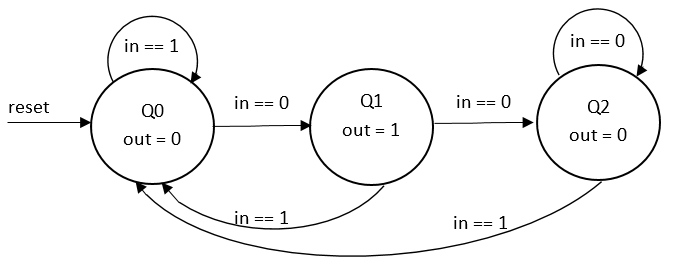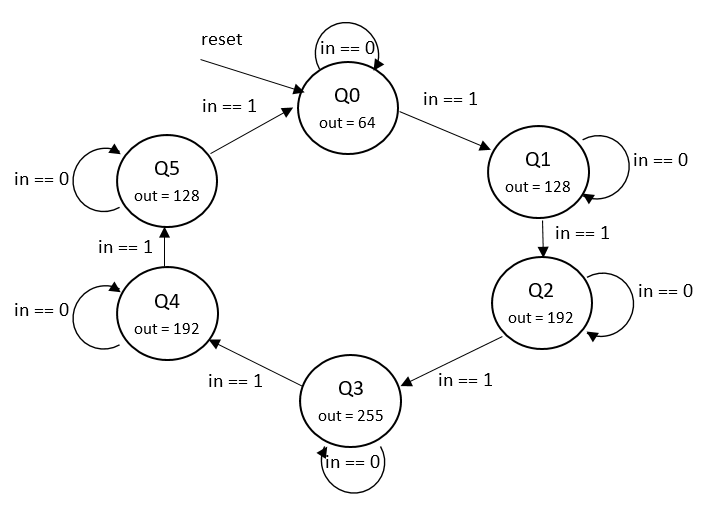CID Aplicatii 13
De la WikiLabs
Jump to navigationJump to searchAutomate finite. Exercitii
Exercitiul 1
Sa se implementeze un circuit care genereaza un semnal PWM cu un factor de umplere ce variaza triungular, la fiecare front cazator al unui semnal de intrare.
Schema circuitului este:
Modulele componente ale circuitului sunt:
- FallingEdgeDetector: Automat ce detecteaza fronturile descrescatoare ale semnalului de intrare.
- TriangularCounter: Automat ce genereaza la iesire secventa de numere 64, 128, 192, 255, 192, 128, 64.
- Counter: Numarator pe 8 biti cu reset sincron.
- COMP: Comparator cu doua intrari pe 8 biti. Iesirea sa va fi 1 atunci cand counter < out si 0 in rest.
Modulul Counter
module Counter(
input clock,
input reset,
output reg [7:0] count
);
always@(posedge clock) begin
if(reset == 0)
count <= 0;
else
count <= count + 1;
end
endmodule
Modulul COMP
module Comparator(
input [7:0] in0,
input [7:0] in1,
output comp_out
);
assign comp_out = (in0 < in1) ? 1 : 0;
endmodule
Modulul FallingEdgeDetector
Automatul ce detecteaza fronturile descrescatoare are un singur semnal de intrare in, care reprezinta semnalul analizat si o singura iesire, out, generand pe aceasta un puls lung cat o perioada de ceas la fiecare aparitie a unui front descrescator pe in.
Graful automatului este:
module FallingEdgeDetector(
input clock,
input in,
input reset,
output out
);
localparam Q0 = 2'b00;
localparam Q1 = 2'b01;
localparam Q2 = 2'b10;
reg [1:0] state, state_next;
always@(posedge clock) begin
if(reset == 0)
state <= Q0;
else
state <= state_next;
end
always@(*) begin
state_next = state;
case(state)
Q0: begin
if(in == 0) state_next = Q1;
end
Q1: begin
if(in == 1) state_next = Q0;
if(in == 0) state_next = Q2;
end
Q2: begin
if(in == 1) state_next = Q0;
end
default: state_next = Q0;
endcase
end
assign out = (state == Q1);
endmodule
Modulul TriangularCounter
Acest modul este un automat ce genereaza la iesire secventa de numere 64, 128, 192, 255, 192, 128, 64.
Graful automatului este:
module TriangularCounter(
input clock,
input in,
input reset,
output reg [7:0] out
);
localparam Q0 = 3'b000;
localparam Q1 = 3'b001;
localparam Q2 = 3'b010;
localparam Q3 = 3'b011;
localparam Q4 = 3'b100;
localparam Q5 = 3'b101;
reg [2:0] state, state_next;
always@(posedge clock) begin
if(reset == 0)
state <= Q0;
else
state <= state_next;
end
always@(*) begin
state_next = state;
case(state)
Q0: if(in == 1) state_next = Q1;
Q1: if(in == 1) state_next = Q2;
Q2: if(in == 1) state_next = Q3;
Q3: if(in == 1) state_next = Q4;
Q4: if(in == 1) state_next = Q5;
Q5: if(in == 1) state_next = Q0;
default: state_next = Q0;
endcase
end
always@(*) begin
if(state == Q0)
out = 64;
if((state == Q1) || (state == Q5))
out = 128;
if((state == Q2) || (state == Q4))
out = 192;
if(state == Q3)
out = 255;
end
endmodule
Modulul TOP
Implementarea modulului TOP
module TOP(
input clock,
input reset,
input in,
output comp_out
);
wire w1;
wire [7:0] count, tricount;
FallingEdgeDetector FEDET(
.clock(clock),
.in(in),
.reset(reset),
.out(w1)
);
Counter COUNT(
.clock(clock),
.reset(reset),
.count(count)
);
TriangularCounter TCNT(
.clock(clock),
.in(w1),
.reset(reset),
.out(tricount)
);
Comparator COMP(
.in0(count),
.in1(tricount),
.comp_out(comp_out)
);
endmodule
Implementarea unui modul de test pentru TOP
`timescale 1ns/1ps
module TOP_TB();
reg clock_t;
reg reset_t;
reg in_t;
wire comp_out_t;
initial begin
clock_t = 0;
forever #1 clock_t = ~clock_t;
end
integer idx;
initial begin
reset_t = 0;
in_t = 1;
#2 reset_t = 1;
for(idx=0; idx<8; idx=idx+1) begin
#1000 in_t = 0;
#2 in_t = 1;
end
#2$stop();
end
TOP DUT(
.clock(clock_t),
.reset(reset_t),
.in(in_t),
.comp_out(comp_out_t)
);
endmodule


